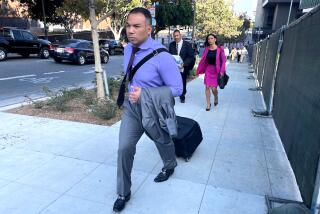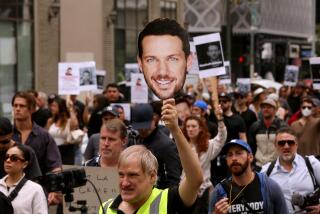L.A. gang member testifies about aftermath of baby’s killing
When he came to, Giovanni Macedo was fast tumbling down the side of an embankment somewhere along a road between Tijuana and Mexicali.
It was a few seconds before he remembered what had happened. Fleeing to Mexico after a botched shooting. Downing a bottle of vodka and teetering up and down Avenida Revolucion in Tijuana. Reaching a second too late to deflect a rope as it was slung over his neck.
A week earlier, the 18-year-old had been “putting in work” in the name of the 18th Street gang in 2007 when he fired shots in the middle of a bustling Westlake street, accidentally killing a 3-week-old infant. The baby’s death made him a hot target, not only for law enforcement, but also for the Mexican Mafia and all the gangs under its reach, including his own.
But if the gang members thought they’d done away with their problem by throwing Macedo off the side of a road, it was too soon. Macedo grabbed onto a handful of dry roots, and climbed back onto the road. He made his way back to the United States, and after a few weeks of hiding out in Utah, contacted the police.
On Thursday, the sharp-jawed young man took the stand to testify against fellow gang members in a federal racketeering trial. Among the defendants on trial is one of his alleged kidnappers, Javier Perez, who, Macedo testified, yelled “Die” as he pulled hard on the rope around Macedo’s neck.
His dramatic turn on the stand capped five weeks of testimony about the gang’s Columbia Lil Cycos clique, which was targeted in a wide-reaching crackdown following the child’s death.
His testimony came the day after Francisco Clemente, the vendor Macedo was targeting when he killed the baby, tearfully recounted the day’s events. Fingering the bullet still lodged next to his own jaw, Clemente said he loved the baby, the son of a woman who was roommates with his girlfriend, like he was his own.
As part of his plea agreement with state prosecutors, Macedo, now 22, is serving 51 years and four months in prison for the baby’s killing. He agreed to cooperate with federal authorities as part of the plea deal.
Macedo said he was jumped into the 18th Street gang around 2005 with a beating that lasted 18 seconds. His loyalty to the gang, he said on the stand, was even greater than his love for his mother, who tried to get him out of the life by moving to Lancaster.
About two years in, he began helping collect “rent” from the illegal vendors that crowd the streets near MacArthur Park in the evenings, selling everything from clothes to electronics. Around the same time, Clemente, who sold radios, cameras and speakers, balked at the increasing demands and refused to pay.
When the topic of shooting Clemente came up on a Saturday morning in September 2007, Macedo volunteered to do it, he testified. He had previously been accused of not putting in enough work.
“I’ll get my respect,” he testified. “That’s basically it, respect.”
He dressed in a black shirt and khakis, and asked a fellow gang member how he looked. He then piled into a truck with other gang members and headed to the clique’s territory.
At a corner doughnut shop, Macedo was handed a cocked .22-caliber pistol. One gang member accompanied Macedo down the street and pointed out the vendor to him as they walked past and into a video store. Macedo stepped out, then from about four feet away, shot four times into the vendor’s head.
“Did you know there was a risk you’d hit other individuals?” Assistant U.S. Atty. Nili Moghaddam asked.
“Yes,” he responded matter-of-factly.
The next day was when he found out something had gone wrong. The clique’s shot-caller paid him a visit, saying a baby had gotten shot and that there could be “consequences” — a “green light” for his death because the killing of a child goes against the Mexican Mafia’s internal rules.
A few days later, Macedo was abruptly told he needed to hide out in Mexico. He and three other 18th Street members drove to Tijuana and spent a couple days drinking and sight-seeing on the Avenida. Someone dared him to finish a bottle of vodka, which he did. A few hours later, in the middle of the night, the others told him they were driving to Mexicali, where he was to hide out.
At a gas station, he was told to get in the front passenger seat. Still recovering from the vodka, he fell asleep for about a minute when he saw, out of the corner of his eye, the rope descending on his neck.
By the time he climbed back onto the road, the sun was up. A truck driver stopped and asked if he had been in a car crash. The driver gave him a bucket of water to clean up the blood and vomit and a collared shirt to cover the bright red bruising on his neck. He dropped Macedo off in Mexicali, where he called his family.
In cross-examination, an attorney for Perez, accused of kidnapping and attempting to kill Macedo, questioned the inconsistencies among Macedo’s initial police interviews, his testimony at the state trial, and his account Thursday.
Macedo initially told police that he wasn’t the shooter but the one tasked with taking the gun from the shooter, attorney Lawrence Litman noted. He later admitted in the same interview that he was the one who fired the shots. Litman pointed out that Macedo has changed his story about who was in the car on the way to the shooting, and when it was that he realized the vendor was going to be killed rather than beaten.
The attorney questioned Macedo’s identification of Perez, whom he had testified he first met the night they drove to Mexico.
“You don’t forget the face of the person who tried to kill you,” Macedo said.
More to Read
Sign up for Essential California
The most important California stories and recommendations in your inbox every morning.
You may occasionally receive promotional content from the Los Angeles Times.











